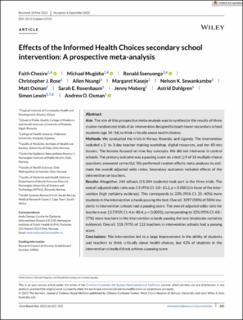Effects of the Informed Health Choices secondary school intervention: A prospective meta-analysis
Chesire, Faith Chelagat; Mugisha, Michael; Ssenyonga, Ronald; Rose, Christopher James; Nsangi, Allen; Kaseje, Margaret; Sewankambo, Nelson K.; Oxman, Matt; Rosenbaum, Sarah Ellen; Moberg, Jenny Olivia Jenkins; Dahlgren, Astrid; Lewin, Simon Arnold; Oxman, Andrew David
Peer reviewed, Journal article
Published version
Permanent lenke
https://hdl.handle.net/11250/3105313Utgivelsesdato
2023Metadata
Vis full innførselSamlinger
Originalversjon
Journal of Evidence-Based Medicine (JEBM). 2023, 16 (3), 259-321. 10.1111/jebm.12552Sammendrag
Aim: The aim of this prospective meta-analysis was to synthesize the results of three
cluster-randomized trials of an intervention designed to teach lower-secondary school
students (age 14–16) to think critically about health choices.
Methods: We conducted the trials in Kenya, Rwanda, and Uganda. The intervention
included a 2- to 3-day teacher training workshop, digital resources, and ten 40-min
lessons. The lessons focused on nine key concepts. We did not intervene in control
schools. The primary outcome was a passing score on a test (≥9 of 18 multiple-choice
questions answered correctly). We performed random effects meta-analyses to esti-
mate the overall adjusted odds ratios. Secondary outcomes included effects of the
intervention on teachers.
Results: Altogether, 244 schools (11,344 students) took part in the three trials. The
overall adjusted odds ratio was 5.5 (95% CI: 3.0–10.2; p < 0.0001) in favor of the inter-
vention (high certainty evidence). This corresponds to 33% (95% CI: 25–40%) more
students in the intervention schools passing the test. Overall, 3397 (58%) of 5846 stu-
dents in intervention schools had a passing score. The overall adjusted odds ratio for
teachers was 13.7(95% CI: 4.6–40.4; p < 0.0001), corresponding to 32% (95% CI: 6%–
57%) more teachers in the intervention schools passing the test (moderate certainty
evidence). Overall, 118 (97%) of 122 teachers in intervention schools had a passing
score.
Conclusions: The intervention led to a large improvement in the ability of students
and teachers to think critically about health choices, but 42% of students in the
intervention schools did not achieve a passing score.

